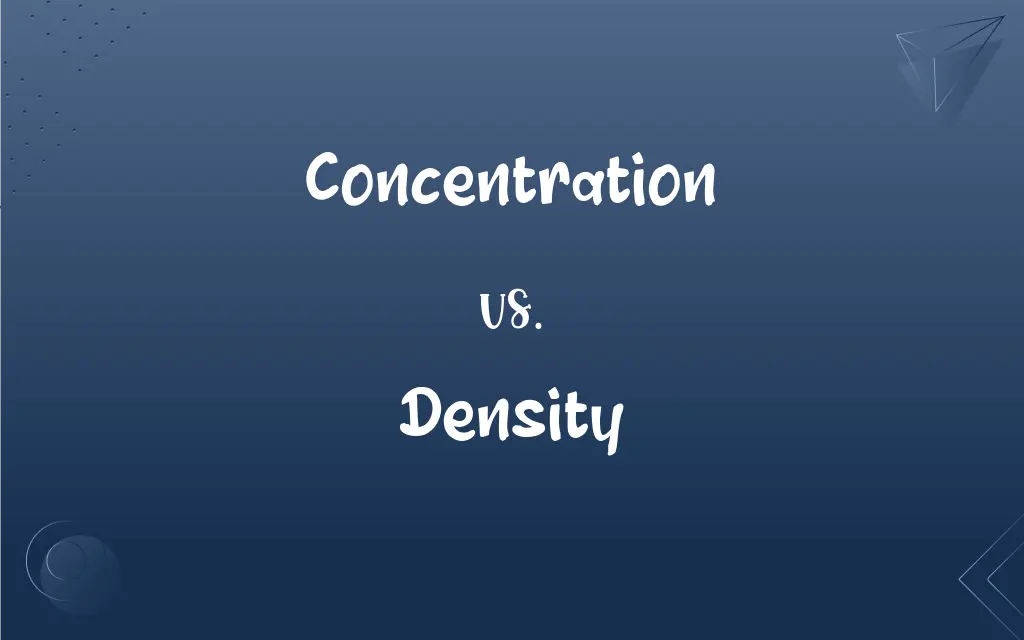Concentration vs. Density: What's the Difference?
Edited by Harlon Moss || By Janet White || Published on January 16, 2024
Concentration is measure of the amount of a substance within a specific volume of a solution. Density is the mass of a substance per unit volume.

Key Differences
Concentration in chemistry refers to the amount of a substance within a certain volume of a solution or mixture. It is often expressed in terms like molarity or mass per unit volume. Density, however, is a physical property of a material, defined as its mass per unit volume, and is a measure of how compact the mass in a substance is.
The concentration of a solution can change when more solute is added or the solution is diluted, affecting the proportion of solute to solvent. Density remains constant for a pure substance at a given temperature and pressure, regardless of the sample size. Concentration is specific to solutions and mixtures, whereas density is a property of pure substances as well as mixtures.
High concentration means a greater amount of solute in a given volume, but it doesn't necessarily imply a high density. Density is independent of the amount of material, so a dense substance will have the same density whether there is a lot or a little of it. Concentration can be altered by changing the volume, while density changes usually require a change in the material’s physical state.
In laboratory settings, concentration is crucial in chemical reactions and preparations, determining the reactant's strength and the reaction rate. Density is often used in identifying substances and understanding their buoyancy and material properties. Concentration measurements are key in fields like pharmacology and biochemistry, while density is essential in fields like material science and engineering.
Concentration and density are distinct but important measurements in science. Concentration measures how much of a substance is present in a certain volume of solution, while density measures the mass of a substance per unit volume. Both are fundamental in understanding the properties and behaviors of substances in various scientific contexts.
ADVERTISEMENT
Comparison Chart
Definition
Amount of substance in a given volume
Mass of substance per unit volume
Dependence on Volume
Changes with volume
Constant for a given material
Related to
Solutions and mixtures
Pure substances and mixtures
Measurement Units
Molarity, mg/mL, etc.
G/cm³, kg/m³, etc.
Typical Applications
Chemical solutions, pharmacology
Material properties, buoyancy
ADVERTISEMENT
Concentration and Density Definitions
Concentration
Concentration is the amount of a solute in a given volume of solvent.
The concentration of salt in seawater affects its freezing point.
Density
Density is the mass of an object divided by its volume.
Lead has a higher density than aluminum, making it heavier for the same volume.
Concentration
It refers to the strength of a solution.
A high concentration of glucose in a solution can make it syrupy.
Density
It's a fundamental property used in material identification.
Gold's high density helps differentiate it from other metals.
Concentration
It indicates how much of a substance is dissolved in a solution.
The concentration of nutrients in a fertilizer solution affects plant growth.
Density
Density is a key factor in determining buoyancy.
Objects with a density less than water will float.
Concentration
Concentration is measured in terms like molarity or mass/volume.
The concentration of acid in a solution determines its pH.
Density
It reflects how closely packed the particles in a substance are.
The density of water changes as it transitions from liquid to ice.
Concentration
Concentration affects the properties and reactions of solutions.
The concentration of reactants can change the rate of a chemical reaction.
Density
Density varies with temperature and pressure.
The density of air decreases at higher altitudes.
Concentration
The act or process of concentrating, especially the fixing of close, undivided attention.
Density
The quality or condition of being dense.
Concentration
The condition of being concentrated.
Density
The quantity of something per unit measure, especially per unit length, area, or volume.
Concentration
Something that has been concentrated.
FAQs
What is concentration?
The amount of a substance in a given volume of solution.
What is density?
Mass per unit volume of a substance.
Can concentration change with volume?
Yes, concentration changes if volume or amount of solute changes.
How is concentration measured?
In units like molarity or grams per liter.
How is density measured?
Typically in grams per cubic centimeter or kilograms per cubic meter.
Does density change with size?
No, density is constant for a material at a given temperature and pressure.
Why is density important in engineering?
It helps in material selection and design considerations.
Can concentration be zero?
Yes, when there is no solute in the solvent.
How does temperature affect concentration?
It can change the solubility of a substance, thus affecting concentration.
Does pressure affect density?
In gases, yes; in liquids and solids, the effect is minimal.
Can changes in concentration affect physical properties?
Yes, like boiling point and freezing point.
Can two substances have the same density but different concentrations?
Yes, especially if they are different substances.
What's an example of a high-density substance?
Metals like osmium and iridium.
Is concentration important in medicine?
Yes, particularly in dosing of medications.
What's an example of a high concentration solution?
A saturated saltwater solution.
How does dilution affect concentration?
It decreases the concentration of a solution.
How does compaction affect density?
It increases the density by decreasing volume.
Can density be zero?
No, all materials have some density.
Are concentration and density related?
They can be related in solutions, but they are different properties.
Does changing the shape of an object affect its density?
No, density remains the same regardless of shape.
About Author
Written by
Janet WhiteJanet White has been an esteemed writer and blogger for Difference Wiki. Holding a Master's degree in Science and Medical Journalism from the prestigious Boston University, she has consistently demonstrated her expertise and passion for her field. When she's not immersed in her work, Janet relishes her time exercising, delving into a good book, and cherishing moments with friends and family.
Edited by
Harlon MossHarlon is a seasoned quality moderator and accomplished content writer for Difference Wiki. An alumnus of the prestigious University of California, he earned his degree in Computer Science. Leveraging his academic background, Harlon brings a meticulous and informed perspective to his work, ensuring content accuracy and excellence.






































































